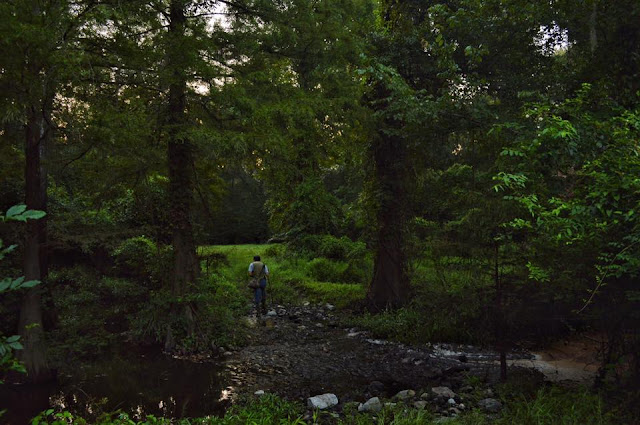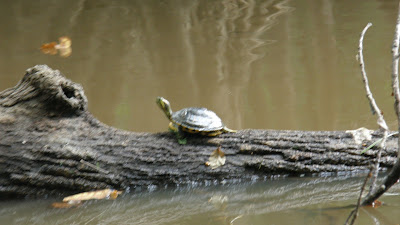I happened upon the area I would call Titan Swamp in early December 2015. It lies along a west-central edge of the Pascagoula Wildlife Management Area (WMA), tucked between the mouth of Black Creek and that of his sister Red Creek a little further south. These two blackwater streams flow southeastward through the Pine Belt to eventually empty into Cypress Creek, an overflow channel of the Pascagoula, which rejoins the greater Pascagoula River some miles downstream. Numerous smaller unnamed channels and sloughs crisscross the muddy bottomland between Red and Black Creeks, ebbing and flowing with the rains, merging for a while when the Pascagoula floods the forest.
In December 2015, I was able to explore a small part of Titan Swamp on foot, and was amazed at the number of huge baldcypress and tupelos that I found there. At that time, my interest lay primarily in seeing for myself the land nearest the creek mouths, and in exploring Woodpecker Island to the east, formed by the overflow channel Cypress Creek. I walked along the edge of drying Titan, then across its lower end, marveling at the trees as names for them formed in my mind. After a half hour or so, I assumed I'd seen its extent, and moved on, leaving the rest of the land between the creeks for another time. When I finally got back there this past September 9, I found I'd been mistaken.
Brian and I drove along the WMA road through Red Swamp to the landing on Cypress Creek, putting in our kayaks a half hour after dawn. It was 61 degrees (Fahrenheit), breezy and clear; hunting season is not yet here, so we had the woods to ourselves. Biting insects made themselves scarce. It was, in short, an almost perfect day to be afield.
I'd thought we would kayak up Cypress Creek to the mouth of Red Creek, then continue up the latter, eventually easing up a small inlet on the north shore; there we would secure the kayaks, then hike northeastward to the edge of Titan Swamp, cut west overland, and bear slowly southward until returning to Red Creek and the kayaks. This we did, mostly, but ended up meandering all the way through Titan Swamp, emerging on the south bank of Black Creek. We sat for a while there, eating snacks and drinking our bottled water, listening to red-headed woodpeckers argue among themselves. From there we cut hard west-southwest, but we overshot our entry route which forced us into a switchback pattern among some wide, wooded sloughs before finally reaching the kayaks near midday.
Our hike took us through some of the finest mature bottomland forest we've yet found in the Basin. Heavy shade, along with frequent flooding from the nearby creeks, means the forest is largely clear of underbrush. Shagbark hickory is common there among the usual water oaks and sweet gums. I was surprised at the number of immense tupelos and baldcypresses lining the many sloughs that link Titan Swamp with the two creeks. Some of the larger sloughs barred our way at times and would have made foot passage impossible in seasons of higher water. White ibises croaked at us as we struggled through the thick gray mud to get better looks at particularly impressive baldcypresses and tupelos. There are, perhaps, more relicts in Titan Swamp per acre than anywhere else in the Pascagoula River Swamp; and Titan itself, as I found out, is not simply restricted to the small tract I'd explored back in 2015, as I had thought. It instead comprises the whole area between lower Black Creek and Red Creek.
(I apologize if my description of the lay of the land is confusing. It is a complex picture, one I am still coming to understand more fully.)
Such impressive habitat, combined with that of the greater Pascagoula River Swamp and the adjoining upland pine forest along the edge of the Basin, could certainly offer strong refuge to any relict population of Ivorybills that might still haunt the area. While we saw no unusual feeding sign or particularly striking woodpecker cavities, "absence of evidence is not evidence of absence," as the saying goes. The quality of the habitat, combined with its remoteness, difficulty of access, and general ruggedness, all give Titan Swamp high marks in my book.
A mixed flock of white ibises, wood storks, and great egrets watched us from Red Swamp as we drove out. The ibises and storks have probably already moved south for the winter. In a couple of months, the forest here will lose much of its foliage, making it harder for big, elusive things to hide from prying eyes. As always, autumn brings a sense of hope and anticipation of what the coming months hold for those of us who walk in old Ivorybill country.
In December 2015, I was able to explore a small part of Titan Swamp on foot, and was amazed at the number of huge baldcypress and tupelos that I found there. At that time, my interest lay primarily in seeing for myself the land nearest the creek mouths, and in exploring Woodpecker Island to the east, formed by the overflow channel Cypress Creek. I walked along the edge of drying Titan, then across its lower end, marveling at the trees as names for them formed in my mind. After a half hour or so, I assumed I'd seen its extent, and moved on, leaving the rest of the land between the creeks for another time. When I finally got back there this past September 9, I found I'd been mistaken.
Brian and I drove along the WMA road through Red Swamp to the landing on Cypress Creek, putting in our kayaks a half hour after dawn. It was 61 degrees (Fahrenheit), breezy and clear; hunting season is not yet here, so we had the woods to ourselves. Biting insects made themselves scarce. It was, in short, an almost perfect day to be afield.
I'd thought we would kayak up Cypress Creek to the mouth of Red Creek, then continue up the latter, eventually easing up a small inlet on the north shore; there we would secure the kayaks, then hike northeastward to the edge of Titan Swamp, cut west overland, and bear slowly southward until returning to Red Creek and the kayaks. This we did, mostly, but ended up meandering all the way through Titan Swamp, emerging on the south bank of Black Creek. We sat for a while there, eating snacks and drinking our bottled water, listening to red-headed woodpeckers argue among themselves. From there we cut hard west-southwest, but we overshot our entry route which forced us into a switchback pattern among some wide, wooded sloughs before finally reaching the kayaks near midday.
Our hike took us through some of the finest mature bottomland forest we've yet found in the Basin. Heavy shade, along with frequent flooding from the nearby creeks, means the forest is largely clear of underbrush. Shagbark hickory is common there among the usual water oaks and sweet gums. I was surprised at the number of immense tupelos and baldcypresses lining the many sloughs that link Titan Swamp with the two creeks. Some of the larger sloughs barred our way at times and would have made foot passage impossible in seasons of higher water. White ibises croaked at us as we struggled through the thick gray mud to get better looks at particularly impressive baldcypresses and tupelos. There are, perhaps, more relicts in Titan Swamp per acre than anywhere else in the Pascagoula River Swamp; and Titan itself, as I found out, is not simply restricted to the small tract I'd explored back in 2015, as I had thought. It instead comprises the whole area between lower Black Creek and Red Creek.
(I apologize if my description of the lay of the land is confusing. It is a complex picture, one I am still coming to understand more fully.)
Morning on Cypress Creek. Photo: Brian Carlisle.
Slipping into another world. Photo: Brian Carlisle.
Nearing the mouth of Red Creek. Photo: Brian Carlisle.
Photo: Brian Carlisle.
Photo: Brian Carlisle.
Photo: Brian Carlisle.
Photo: Brian Carlisle.
We saw two young raccoons up a tree during our hike. Photo: Brian Carlisle.
Photo: Brian Carlisle.
Titan Swamp, near Black Creek. Photo: Brian Carlisle.
Photo: Brian Carlisle.
Another view of Titan.
The mud here is deep and treacherous.
We pause to rest by Black Creek.
"Mine eyes have seen the glory." Photo: Brian Carlisle.
Photo: Brian Carlisle.
Raccoon-work. Photo: Brian Carlisle.
Not far from Black Creek, we found an enormous tupelo, which Brian named 'Fat Bottomed Girl.' Photo: Brian Carlisle.
I'm not sure if Fat Bottomed Girl is just one tree, or two.
Brian likened the roots of this tree to a flowing gown.
The largest of the relict baldcypresses we encountered, safe from our close inspection in his deep slough. I had difficulty getting a photo.
I have named this tree the Hurliman Cypress, in honor of my friend Dean Hurliman of Iowa, carver, poet, and kindred spirit. Dean's carving of a male Ivorybill in flight hangs above my desk as I type this, one of several he has very generously gifted to others in the Ivorybill community; he recently sent a pair to the Audubon Center at Moss Point, MS. Dean, you may be in Iowa, but you are always with us.
Screen shot from Brian's phone showing location of the Hurliman Cypress (large blue dot). The large stream flowing generally north-south in the middle is Cypress Creek. The Hurliman Cypress lies between Black Creek to the north and Red Creek to the south. East of Cypress Creek lies Woodpecker Island.
Screen shot showing latitude and longitude of the Hurliman Cypress.
Another view of Black Creek. Photo: Brian Carlisle.
Photo: Brian Carlisle.
Photo: Brian Carlisle.
Photo: Brian Carlisle.
Photo: Brian Carlisle.
Another view of the shy Hurliman Cypress. Photo: Brian Carlisle.
Photo: Brian Carlisle.
Photo: Brian Carlisle.
Typical bottomland near Red Creek. Photo: Brian Carlisle.
Photo: Brian Carlisle.
Photo: Brian Carlisle.
This giant sat safely ensconced on an island of impossibly thick mud. Photo: Brian Carlisle.
Sloughs can be surprisingly deep, warranting careful inspection. Photo: Brian Carlisle.
Photo: Brian Carlisle.
Me, over-thinking a challenge again. Photo: Brian Carlisle.
Maybe I'm getting to old for this. I hope not. Photo: Brian Carlisle.
My kayak, a most welcome sight after our long swamp hike. Photo: Brian Carlisle.
Photo: Brian Carlisle.
Beautiful Red Creek, with Cypress Creek in the distance. Photo: Brian Carlisle.
Photo: Brian Carlisle.
Such impressive habitat, combined with that of the greater Pascagoula River Swamp and the adjoining upland pine forest along the edge of the Basin, could certainly offer strong refuge to any relict population of Ivorybills that might still haunt the area. While we saw no unusual feeding sign or particularly striking woodpecker cavities, "absence of evidence is not evidence of absence," as the saying goes. The quality of the habitat, combined with its remoteness, difficulty of access, and general ruggedness, all give Titan Swamp high marks in my book.
A mixed flock of white ibises, wood storks, and great egrets watched us from Red Swamp as we drove out. The ibises and storks have probably already moved south for the winter. In a couple of months, the forest here will lose much of its foliage, making it harder for big, elusive things to hide from prying eyes. As always, autumn brings a sense of hope and anticipation of what the coming months hold for those of us who walk in old Ivorybill country.




























































































